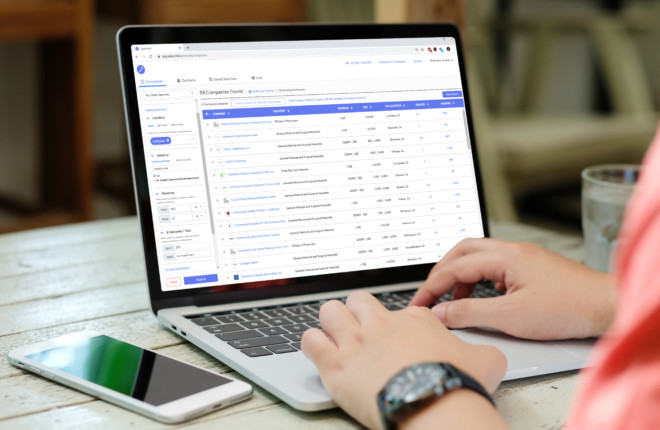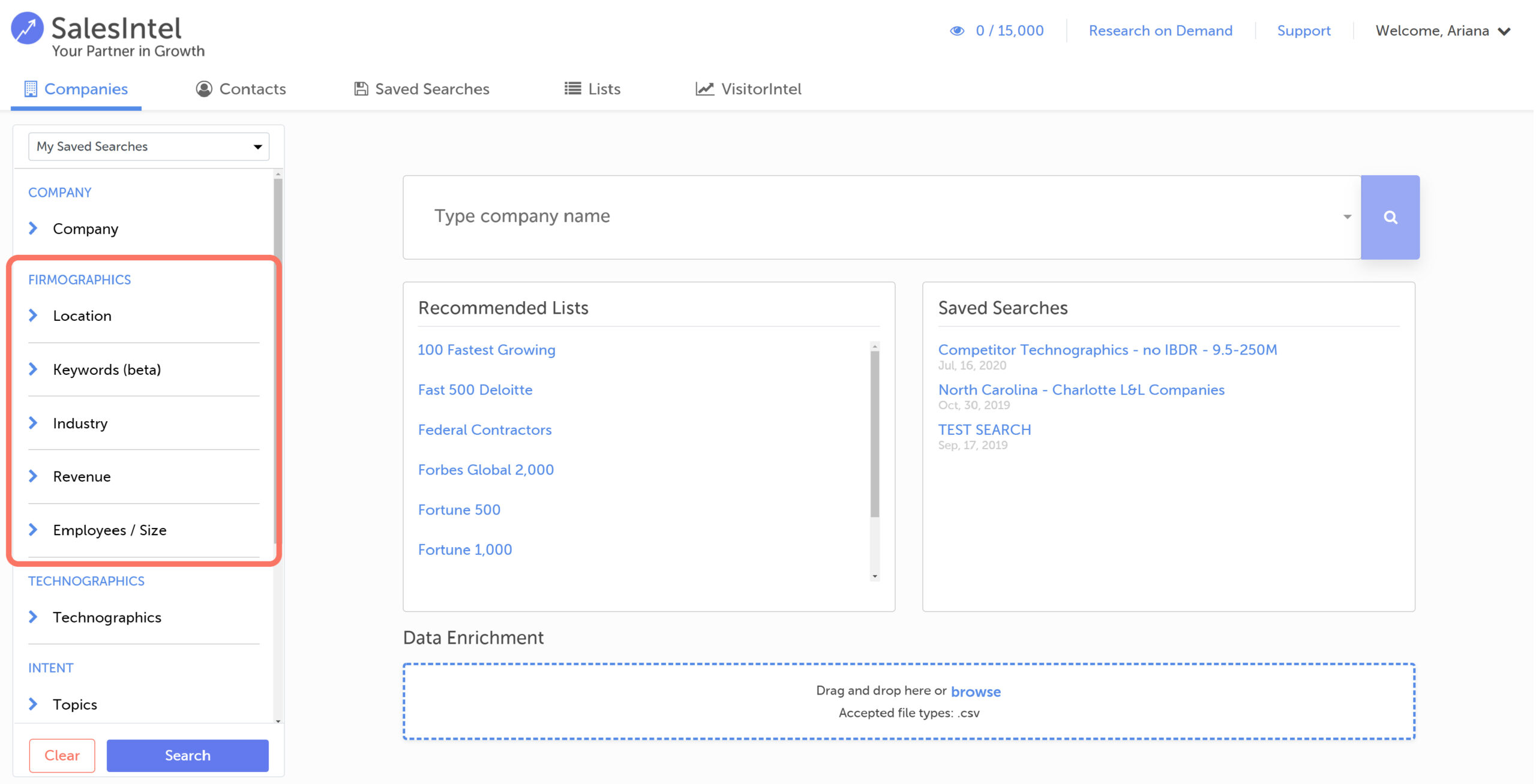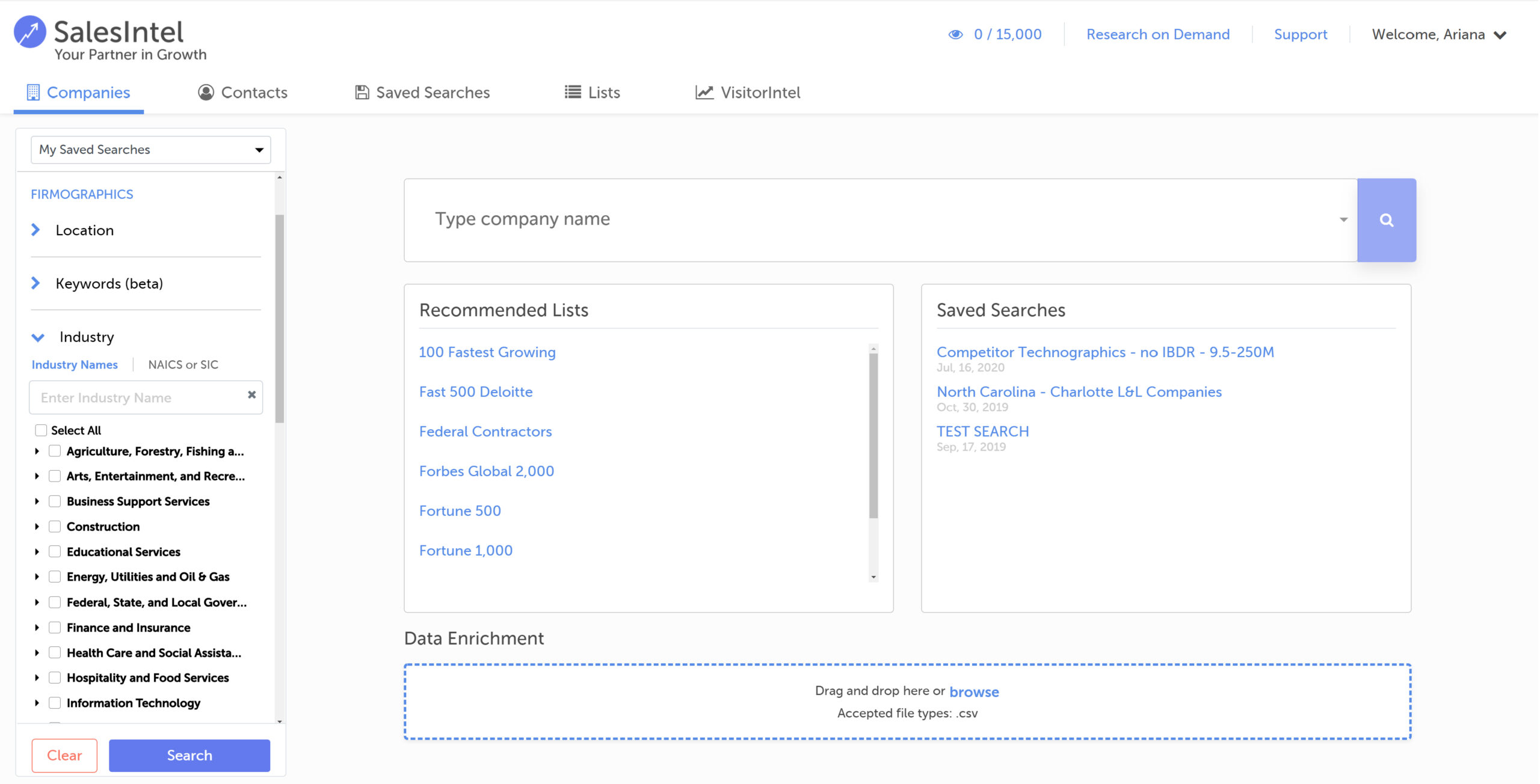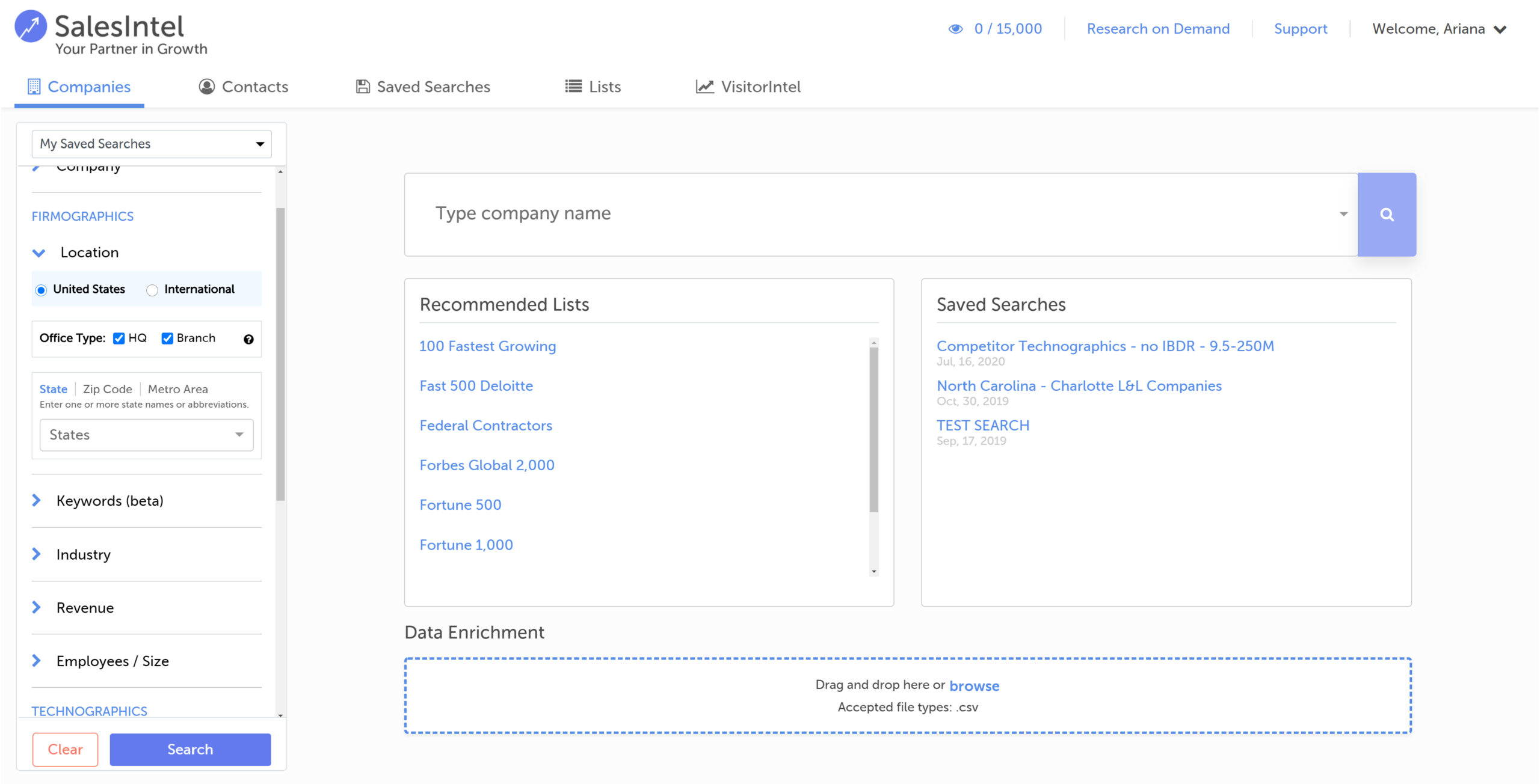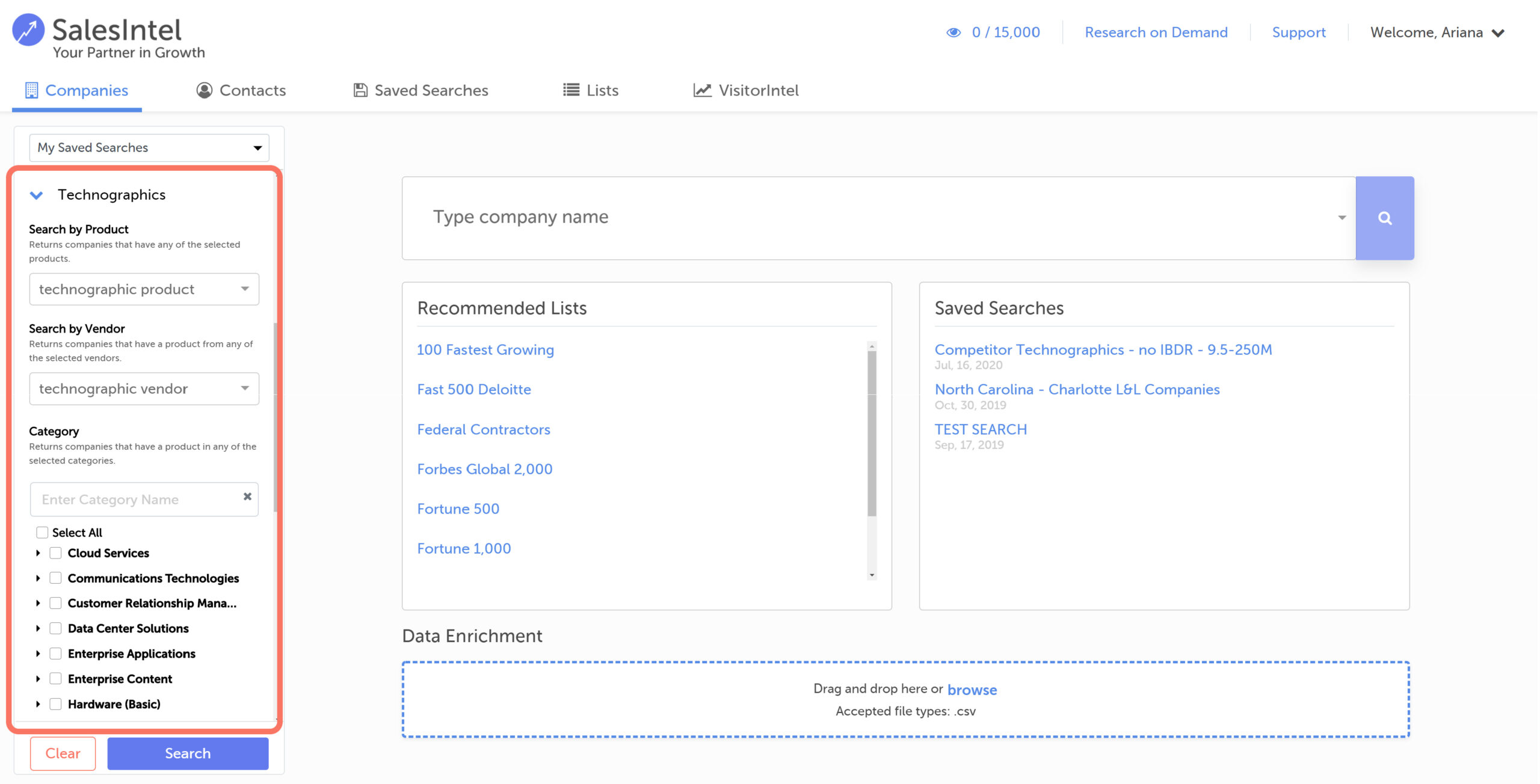Every marketer and sales manager wants to use market segmentation to paint a more realistic image of their customer base. However, one of the top concerns of B2B companies is identifying and profiling the characteristics and behaviors of consumers through the process of data segmentation.
When it comes to segmenting accounts to target for marketing campaigns or sales activities, you have a lot to pick from. So, how can you narrow things down to make segmenting simpler, sharper, and more effective? The answer: Data.
Technographics and firmographic data are two data types that can be extremely valuable for audience segmentation.
Here’s how each of these types of data can help:
- Technographic data:
Technographic data provides information about the technology usage of your target audience. This can include information about their devices, the software and apps they use, their online behavior, and more. Technographic data can be used to segment your audience based on the technology, tools, and IT infrastructure they use.
- Firmographic data:
Firmographic data provides information about the companies or organizations that make up your target market. This can include information about the company’s size, industry, location, and more. Firmographic data can be used to segment your audience based on their specific business needs and challenges.
By combining technographic and firmographic data with other types of data such as demographic and psychographic data, you can create highly targeted audience segments more likely to be receptive to your marketing messages. By understanding the unique needs and preferences of each segment, you can create more effective marketing campaigns that drive positive results.
Firmographic Segmentation for B2B Businesses
B2B marketers leverage firmographics like B2C marketers use demographic data. It is a method of segmenting customers based on their shared qualities. Firmographic segmentation is the grouping of B2B customers based on mutual enterprise or corporate characteristics. It groups customers based on firmographic data such as business size (either by the number of employees or annual revenue), company location (i.e. inner-city Chicago versus rural Utah), industry, executive title, etc.
Segmenting data based on firmographics helps marketing and sales managers get a deeper company perspective and eventually create more oriented and successful promotional campaigns.
The better you know a prospect, the more intimate the value proposition you will give, and the greater the likelihood that it will resonate and result in the move you want to take.
Technographic Segmentation for B2B Businesses
Technographic segmentation will offer major benefits to B2B marketers. To build customer profiles, recognize pain points, and optimize tailored marketing campaigns, technographic data can give you a lot of benefits. Many companies now rely on their technology stack to drive growth, competitiveness, customer relationships, and more — regardless of the industry.
If you’re in the B2B market, learning how technology works with an enterprise is worth learning.
For example – your company may discover that your biggest clients are using marketing automation tools like Marketo or Eloqua. These pieces of software signify more than just the fact that an organization uses marketing automation. Marketo and Eloqua businesses are typically big, with tens or hundreds of thousands of contacts, significant resources, and technological know-how. You can extend these identifiers to find new potential customers.
Given the importance of firmographic data and technographics, you need to understand the factors and variables that you should consider while segmenting the data.
The Combined Power: Leveraging Firmographics and Technographics for Effective Segmentation
Using firmographic and technographic data lets you target and reach better accounts. The more data you have about your potential market, the better decisions you can make while segmenting the qualified prospects.
SalesIntels provides the ‘must-have’ data filter variables B2B marketers use to create a targeted segment using firmographic and technographic data. Here are a few of the best and how you can use them effectively:
1. Industry
The industry type is a natural variable because some sectors are more likely to be interested in certain products and services.
If you have a large and varied database in your CRM, targeting all B2B companies with general messaging will not work. Instead, an industry-focused marketing campaign is the right approach. Thus, segmentation based on industry becomes crucial since promoting the same content to every industry and hoping your message resonates will lower your chances of generating qualified leads.
2. Revenue
Looking at revenue is important because you want to sell to certain companies who can reasonably afford what you’re selling rather than waste ad expenditure on prospects who can’t.
Your software might be more economical than your competitors and thus more popular with smaller businesses with lower annual sales. Naturally, you want to reach the smaller businesses more likely to be enthusiastic by your bid than the Fortune 500 business with more sales that runs on a much larger scale.
3. Company size
The number of employees working in a company matter as different-sized businesses are likely to respond differently to your marketing and promotional strategies.
If you use business size as a firmographic variable, ask yourself:
- Is your target business a large enterprise, or are they operating on a smaller scale?
- Are they in the growing phase or are they downsizing?
Is your product ideal for small entrepreneurs, growing mid-size firms, or established businesses?
Answering these questions and segmenting the audience correctly makes it easier to take a more personalized approach.
4. Location
Location firmographic refers to where the target company is geographically located — city, state, area, country, continent, etc.
- Are they in a metropolitan city or a small town?
- Is it a foreign brand?
- What’s the location of the company?
It may not be wise to target a Southeast Asian company that does not do a lot of business with American companies. Businesses that do not spend a lot of time or budget engaging with American businesses are not a good fit.
5. Performance
Firmographic segmentation by performance is a classification of companies based on attributes relevant to the conduct of activity over time:
- Year of incorporation
- Growth rate or drop
- Profits and losses
This information will help you prioritize leads and prospects and decide whether your solution is a good fit for them or not. For example, if you are selling technology or an automation tool, then companies that are incorporated for more than 15-20 years and doing well will be hesitant to break their manual process and automate their operations. They are often happy with the way they work.
6. Executive Title
All of the above firmographic variables help you to determine the ideal customer profile (ICP – similar to the client, except at the business level). However, they also assist you in account-based marketing (ABM).
ABM is important to influence those responsible for buying decisions, and executive title firmographics make it easy to draw up lists of those particular entities and accounts.
Irrespective of the ultimate aim, the trick to ABM is to reach the right accounts at the right time — and firmographic data is one of the easiest ways to do this.
7. Technology Used
In its broadest context, ‘technographics’ is a short word for ‘technographic segmentation.’
It is a means of evaluating statistical data generated by a population or group based on their possession and use of technology. It is a consumer segmentation class, such as Demographics and Firmographic data.
Technographic data is a way of recognizing the technology stack of an organization.
- What kind of hardware and applications are they using?
- What tools and technologies are there?
- How do they incorporate and use their different systems and platforms?
If you want to survive in the rising competition, you should give yourself every available competitive edge.
By integrating technographics into account profiling activities, you can obtain a more reliable portrayal of the Total Addressable Market (TAM).
Once you know the technology stack of your prospects, you can tailor your marketing campaigns for the initial touch.
By tailoring your message to the unique needs of the consumer, you maximize the likelihood of constructive response, as it reveals that you have taken the time to consider their current problems.
Firmographic market segmentation offers useful information to educate and enhance promotional campaigns. By combining shortlisted potential accounts based on firmographic and technographic data, you are likely to benefit from laser-focused ad campaigns, more appropriate messaging, and improved ROI. Once you start using them for segmentation and to guide marketing and sales decisions, you will see a range of benefits.
Let’s look at some use cases where technographic and firmographic data can make a huge difference.
Technographic and Firmographic Data: Use Cases
1. Quickly Identify Qualified Sales Leads
If you start integrating firmographic and technographic details into your sales workflow, segmenting qualified prospects becomes easy.
You can use SalesIntel to filter and find companies that match your needs instantly.
Is your answer applicable to B2B SaaS firms with more than $500K ARR, and you just want to see businesses based in Austin, Chicago, and NYC? You will see any business that suits your specifications in a few clicks.
SalesIntel helps every organization ramp up its lead generation activities by leveraging technographic data. With 300 million technographic data points you can better define opportunities and drive decision-making.
2. Improve Sales And Marketing Messaging
You need to personalize every marketing campaign and message you can. If a prospect doesn’t think your email or call is important, he or she won’t get in contact with you again.
If you start using firmographic and technographic data, you will be able to speak to prospects and have more value than ever before. Getting an awareness of the opportunities for business growth, the size of the organization, locations, and other critical details will allow your staff to know valuable information about a prospect’s company and personalize their sales presentations and marketing communications.
3. Optimize Your Ad Targeting
Advertising based on profiling is challenging. If you make the wrong decisions, you are likely to waste your ad budget targeting uninterested viewers. Firmographic and Technographic data can help to set up a more focused ad campaign.
Once you discover the perfect prospect data, you can use the data to target your ads more efficiently. For example, if you are running advertisements on LinkedIn, you can target viewers with a variety of different types of firmographic data. SalesIntel helps find companies that fulfill the firmographic criteria to be listed as leads and then connect those companies directly to your LinkedIn audience.
That way, you know that your money is being used wisely. The decision-makers you care for will see your campaigns, and you won’t spend time on unqualified prospects.
4. Improve Customer Retention
Maintaining and forging long-term, mutually beneficial customer relationships is always your ultimate aim.
You will have better business analysis and will be able to predict business-driven problems involving at-risk accounts. You can also use your experience to guide product growth (for example, if you can consider your customers implementing a solution that you might offer).
Knowing who uses competing products or technologies will create ways to gain market share by encouraging the targeting of the right customer base.
Many of these advantages and other targets are related to consumer satisfaction (upselling, cross-selling, extension, and expansion opportunities). They can be realized with the proper implementation of strategic segmentation, which is why so many businesses have already integrated digital analytics into their marketing and customer research efforts.
Wrapping Up
Technographic and firmographic data aren’t an end in themselves. However, they are critical components of customer experience and client engagement in the modern age. If firmographic data and technographics are supported by buyer’s intent data, then your team can master the art of segmenting and selling in the B2B landscape.
When the sales and marketing staff has accurate B2B data, their marketing efforts will improve, and they will be able to tailor the message successfully.

